Sights and Activities
Below are the places we saw and activities completed while visiting Cuba:
Havana
Antonio Maceo Monument: this bronze monument was in memory of the mulato general who crossed the entire length of the country during the First War of Independence.
Torreon de San Lorenzo: this 18th-century watchtower quickly fell to the British during the invasion of 1762.
Malecon: we found ourselves strolling on this thoroughfare several times. We found ourselves enjoying the breeze, the classic cars cruising, and trying to find the perfect opportunity and location to capture it all with our camera. The 8km-long sea drive was first laid out in the early 1900’s and by the early 1950’s it had metamorphosed into a busy six-lane highway that stretches from Castillo de San Salvador de la Punta to the borders of Miramar.


Hotel Nacional: this hotel located on a hill just off the Malecon was built in 1930. The grounds provide great downward views of the Malecon. The hotel turned infamous after two events, the first in October 1933 after Fulgencio Batista’s coup toppled the regime of Gerardo Machado, 300 army officers took refuge in the building hoping to get help from resident US ambassador, but the ambassador promptly left, allowing Batista’s troops to open fire on the hotel. The other incident in December 1946, US mobsters used it to host the largest ever get-together of the North American Mafia, who gathered here under the disguise of a Frank Sinatra concert.
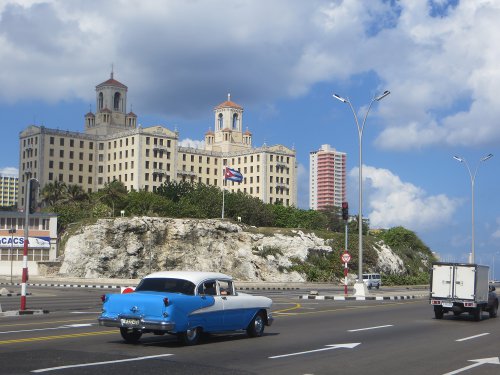
Avenida de los Presidentes: also known as Calle G (G Street), statues of Latin American leaders line the street, including Salvador Allende, Benito Juarez, and Simon Bolivar. At the top of the avenue is a huge marble Monumento a Jose Miguel Gomez, Cuba’s second president. At the other end, the monument to his predecessor, Cuba’s first president, Tomas Estrada Palma has been toppled, with just his shoes remaining on the original stand. Tomas Estrada Palma was considered a US puppet. Guarding the entrance to the avenue on the Malecon is the equestrian Monumento a Calixto Garcia, paying homage to the valiant Cuban general who was prevented by US military leaders in Santiago de Cuba from attending the Spanish surrender in 1898.
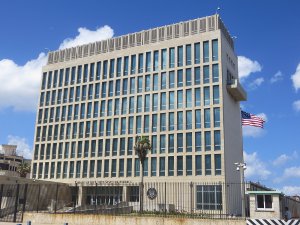
US Interests Section: a modern seven-story building set up by the Carter administration in the late 1970’s. Shortly prior to our arrival the US president, Barack Obama, had visited to open the building as the US Embassy.
Monumento a las Victimas del Maine: this monument is dedicated to the victims of USS Maine, the battleship that blew up mysteriously in Havana harbor in 1898.
Edificio Lopez Serrano: one of the city’s first skyscrapers that was built in 1932 and now houses apartments.
Gran Synagoga Bet Shalom: one of three synagogues in the country to service a Jewish population of approximately 1500.

Edificio Focsa: this modern building was built between 1954 and 1956 in a record 28 months using pioneering computer technology. With 39 floors, it was upon its completion the second-largest concrete structure of its type in the world, constructed entirely without the use of cranes.
Coppelia Ice Cream: the city’s famous ice cream parlor is known for its long lines and affordable ice cream. Popular since opening in 1966, the state-run institution offers ice cream for 20 US cents. There is a smaller outdoor section where tourists do not have to wait, but pay a larger premium. We decided to wait in line and receive a real Cuban experience. Waiting in line is very organized in Cuba; unfortunately people have become accustomed to it. After over an hour waiting, we finally entered, sat in a shared table (which is typical), and a waitress came up to us and said “strawberry.” She did not take the time to explain that there is only strawberry or to greet us, just “strawberry.” Unfortunately after years of just surviving, Cuba is not on the top of the list for customer service.

Hotel Habana Libre: this hotel was former Havana Hilton. It was seized by Castro’s revolutionaries in 1959 just nine months after it had opened and promptly renamed the Habana Libre. During the first few months of the Revolution, Fidel ruled the country from a luxurious suite on the 24th floor.
Monumento a Julio Antonio Mella: this monument is dedicated to the student leader who founded the first Cuban Communist Party in 1925. Mella was assassinated in Mexico City in 1929 by the dictator Machado.
Universidad de la Habana: this university was founded by Dominican monks in 1728 and secularized in 1842. It previously was located in Habana Vieja before moving in 1902 to its present site in a Vedado hill. Today some 30,000 students go up the famous escalinata (stairway) to take courses in social sciences, humanities, natural sciences, mathematics, and economics.
Biblioteca Nacional Jose Marti: located in the Plaza de la Revolucion, this library was built in 1957.
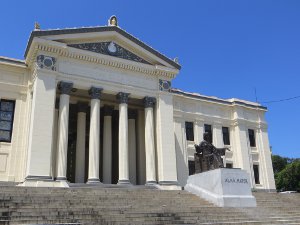
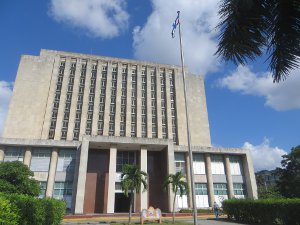
Plaza de la Revolucion: this gigantic plaza, known as Plaza Cívica until 1959, is surrounded by gray buildings constructed in the late 1950s. One of the buildings on the North side of the plaza is the Ministerio del Interior, famously known for its huge mural of Che Guevara (a copy of Alberto Korda’s famous photograph taken in 1960) with the words ‘Hasta la Victoria Siempre’ (Always Toward Victory). In 2009, a similarly designed image of another guerilla hero, Camilo Cienfuegos, was added on the adjacent Telecommunications Building with the words ‘Vas Bien Fidel’ (You’re going well, Fidel). In the center of the plaza is Memorial a Jose Marti, which at 138.5m (454 ft) is the city’s tallest structure.

Teatro Nacional de Cuba: built in the 1950’s, this theater hosts concerts, foreign theater casts, and La Colmenita children’s company.
Iglesia del Sagrado Corazon de Jesus: this church is one of Cuba’s few Gothic buildings.
El Barrio Chino: the city’s Chinatown is known for its lack of Chinese people, most of who left as soon as a newly inaugurated Fidel Castro uttered the word ‘socialism.’ The first Chinese arrived in the late 1840’s as contract laborers. By the 1920’s, the city’s Chinatown had grown to the biggest Asian neighborhood in Latin America. In the 1990’s, the Cuban government invested money and resources into rejuvenating the district. We walked around the historical area and ate at one of the many Chinese restaurants.
Museo Casa Natal de Jose Marti: this tiny museum opened in 1925 and is set in the house where Cuban independence hero was born on January 28, 1853. It is considered to be the oldest museum in Havana. There were many photos and artifacts of Marti.

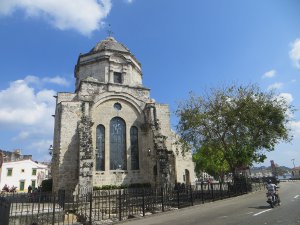
Old City Walls: built between 1674 and 1740, this 5km-long city wall measured 1.5m thick and 10m high and was to protect the city from pirates and other invaders. The wall was demolished starting in 1863, but a small segment remains.
Centro Cultural Antiguos Almacenes de Deposito San Jose: the city’s handicraft market sits in an old shipping warehouse.
Iglesia de San Francisco de Paula: we went inside of the chapel of what was left of a former women’s hospital from the mid-1700’s that was fully restored in 2000.
Iglesia y Convento de Nuestra Señora de la Merced: this church was built in 1755 and was reconstructed in the 19th century. The interior feautures beautiful gilded altars and a frescoed vault.
Iglesia Parroquial del Espirutu Santo: this is the city’s oldest surviving church, built in 1640 and rebuilt in 1674.
Iglesia y Convento de Santa Clara: this is the city’s largest and oldest convent built between 1638 and 1643, though since 1920 it has served no religious purpose.
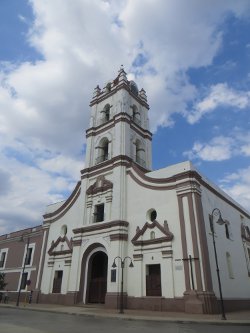
Iglesia y Convento de Nuestra Señora de Belen: this huge 1718 building first functioned as a convalescent home, later as a Jesuit convent, and abandoned in 1925. It is now a community hub for families, young people, the physically and mentally impaired, and the elderly. There are 18 permanent apartments for senior citizens here.
Capitolio Nacional: this building is similar to the Washington, DC Capitol Building, but marginally taller. The work was initiated by Cuba’s US-backed dictator Gerardo Machado in 1926 and took 5000 workers three years, two months and 20 days to build at a cost of US $17 million. It was the seat of the Cuban Congress, but since 1959 it has housed the Cuban Academy of Sciences and the National Library of Science and Technology. Constructed with white Capellanía limestone and block granite, the Capitolio has been undergoing renovations for some time and therefore we were not able to visit the interior.
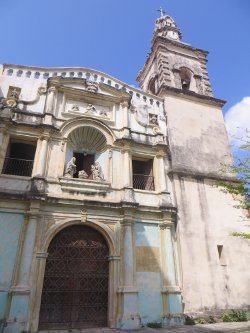
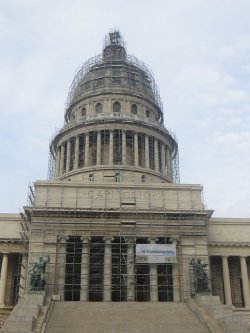
Parque de la Fraternidad: this park was established in 1892 to commemorate the fourth centenary of the Spanish landing in the Americas. A few decades later it was remodeled and renamed to mark the 1927 Pan-American Conference. The name is meant to signify American brotherhood, featuring many busts of Latin and North American leaders.
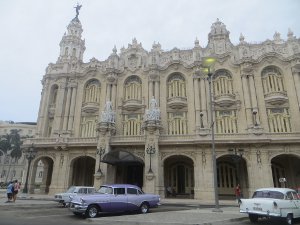
Plaza del Cristo: this plaza is home to the Parroquial del Santo Cristo del Buen Viaje, a church dating from 1732.
Gran Teatro de la Habana: this neobaroque theater was first erected as a Galician social club between 1907 and 1914. It was renovated in 2013 – 14.
Hotel Inglaterra: the city’s oldest hotel first opened its doors in 1856 and features a neoclassical design.
Parque Central: this park is a microcosm of daily Havana life. The main feature of the park is a 1905 marble statue of Jose Marti, which was the first of thousands to be erected in Cuba. It was raised on the 10th anniversary of the poet’s death.
Paseo de Marti (Prado): construction of this boulevard began in 1770 and the work was completed in the mid-1830’s. The original idea was to create a boulevard as splendid as any found in Paris or Barcelona. The thouroghfare is officially known as Paseo de Martí, but the street is universally referred to by its old name, Prado.
Museo de la Revolucion: this museum resides in the former Presidential Palace, constructed between 1913 and 1920. The exhibitons descend chronologically with one floor dedicated to the revolutionary war from 1952 to 1959 and another floor the actions that occurred after the war, including all the US attempts to defeat the revolution, such as the Bay of Pigs invasion. Behind the museum, the Pavillon Granma is a memorial to the 18m yacht that carried Fidel Castro and 81 other revolutionaries from Tuxpán, Mexico, to Cuba in December 1956. The pavilion is also surrounded by other war vehicles associated with the revolution.

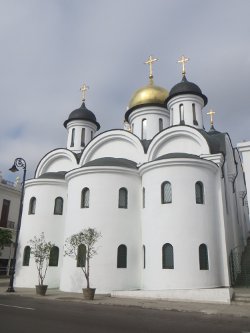
Convento & Iglesia del Carmen: one of the city’s most beautiful church was only built in 1923 to house the Carmelite order.
Callejon de Hamel: this alleyway full of murals and art shops is where we headed to on a Sunday to listen to live music.
Catedral Ortodoxa Nuestra Señora de Kazan: this gold-domed Russian Orthodox Church was built in the early 2000’s and consecrated at a ceremony attended by Raul Castro in October 2008. The church was part of an attempt to reignite Russian-Cuban relations after they went sour in 1991.
Plaza Vieja: laid out in 1559, this plaza (Old Square) was originally called Plaza Nueva (New Square) and now is home to various bars, restaurants, and cafes.
Palacio Cueto: located on the southeast corner of Plaza Vieja, this Gaudí-esque building was constructed in 1906 and has been empty and unused since the early 1990’s.
Iglesia y Monasterio de San Francisco de Assis: this church was originally constructed in 1608 and rebuilt in baroque style from 1719 to 1738, but has ceased to have a religious function since the 1840’s.
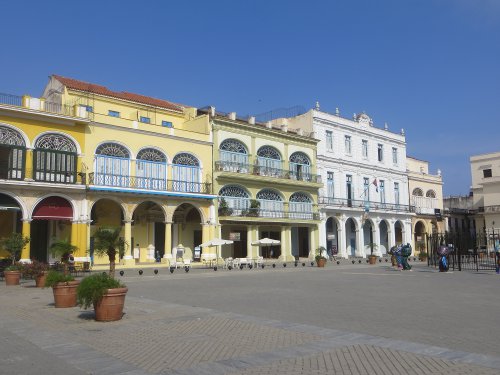
Plaza de San Francisco de Asis: this plaza was built in the 16th century where a market took root, followed by a church in 1608, though when the monks complained of too much noise, the market was moved. The plaza underwent a full restoration in the late 1990’s and contains the white marble Fuente de los Leones (Fountain of Lions) carved in 1836, a more modern statue that depicts El Caballero de Paris (The Paris Gentleman) that was a well-known street person who roamed Havana during the 1950’s engaging passers-by with his philosophies on life, religion, politics and current events, and the domed Lonja del Comercio, a former commodities market erected in 1909 and restored in 1996 to provide office space for foreign companies.
Calle Mercaderes: this pedestrian street (Merchant’s Street) has been extensively restored and is scattered with the museums, shops, and restaurants.
Plaza de Armas: the city’s oldest square was laid out in the early 1520s, soon after the city’s foundation. The center of the square has a marble statue of Carlos Manuel de Cespedes, the man who set Cuba on the road to independence in 1868, which replaced a statue of unpopular Spanish king, Ferdinand VII, in 1955.

Palacio de los Capitanes Generales: in the west side of Plaza de Armas, the palace dates from the 1770’s. From 1791 until 1898 it was the residence of the Spanish captains general. From 1899 until 1902, the US military governors were based here, and during the first two decades of the 20th century the building briefly became the presidential palace. Since 1968, the building has hosted the Museo de la Ciudad (City Museum). The building itself is a beauty, but the dull exhibitions included antique furniture, military uniforms, old-fashioned 19th-century horse carriages, and old photos of the country’s history.
Palacio de los Condes de Santovenia: this late-18th-century palace is now the five-star, 27-room Hotel Santa Isabel.
Castillo de la Real Fuerza: from the outside we were able to enjoy one of the oldest existing forts in the Americas, built between 1558 and 1577.
Palacio del Segundo Cabo: this palace was constructed in 1772 as the headquarters of the Spanish vice-governor. We were able to witness the recently renovated interior of this magnificent building.


Edificio Santo Domingo: the site of the city’s original university, which stood here between 1728 and 1902. It was originally part of a convent. Many of the university’s arts faculties have moved back here.
Hotel Raquel: this hotel is located in a grandiose 1908 palace that was renovated with antique furniture, sleek marble statues, and elaborate stained-glass ceiling.
Casa del Queso La Marriage: we were surprised to taste a great variety of local cheeses and imported wine in this restaurant.
Museo del Ron: this museum explains the history and the making of the famous Havana Club rum. Of course we were also able to get a tasting of one of the rums.
Calle Obispo: this pedestrian street and the heart of Old Havana is packed with art galleries, shops, music bars, and people.
Plaza de la Catedral: this square contains many baroque buildings, including the city’s cathedral, and is the newest of the four squares in the Old Havana with its present layout dating from the 18th century.
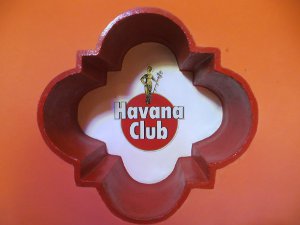

Catedral de San Cristobal de la Habana: with two unequal towers and framed by a baroque facade designed by Italian architect Francesco Borromini, the city’s cathedral began construction in 1748 by the Jesuits and work continued despite their expulsion in 1767. The building was finished in 1787 making it one of the oldest in the Americas.
La Bodeguita del Medio: made famous by Ernest Hemingway, other visitors have also included Salvador Allende, Fidel Castro, Nicolas Guillen, Harry Belafonte, and Nat King Cole, all of who have left their autographs on the wall. We did not their overpriced mojitos, but did walk-by this touristy bar.
Iglesia del Santo Angel Custodio: this church was originally constructed in 1695, but it was pounded by a ferocious hurricane in 1846, after which it was entirely rebuilt in neo-Gothic style. Jose Marti was baptized here 1853.
Parque de los Enamorados: this Lovers’ Park preserves a section of the colonial Tacon Prison, built in 1838, where many Cuban patriots including José Martí were imprisoned. The prison was demolished in 1939 with this park and the two cells that remain are dedicated to the memory of those who had suffered so horribly within its walls.

Statue of General Maximo Gomez: overlooking the mouth of the harbor is this grand statue of war hero from the Dominican Republic who fought tirelessly for Cuban independence in both the 1868 and 1895 conflicts against the Spanish.
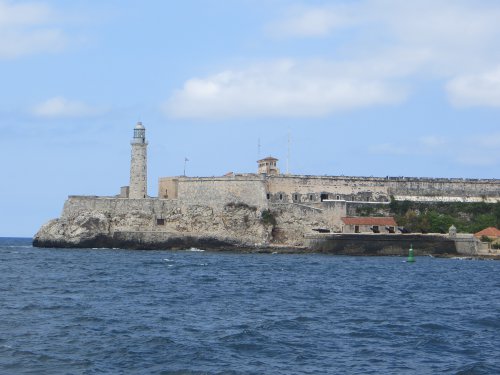
Castillo de San Salvador de la Punta: one of four forts defending the Havana harbor that was designed by the Italian military engineer Giovanni Bautista Antonelli and built between 1589 and 1600. The fort is easily accessible during a Malecon stroll.
Castillo de los Tres Santos Reyes Magnos del Morro: erected between 1589 and 1630 to protect the entrance to Havana harbor from pirates and foreign invaders, this fort is located on the other side of the harbor from the Old Town and easily viewable from the Malecon. For more than a century the fort withstood numerous attacks by French, Dutch, and English privateers, but in 1762 the British force captured El Morro by attacking from the landward side. The views of the sea and the city are fantastic.
Playing “Pelota” (Baseball) in Castillo de los Tres Santos Reyes Magnos del Morro
Fortaleza de San Carlos de la Cabana: this colossal fort was built between 1763 and 1774. After the 1762 British invasion, the Spanish King Carlos III ordered the construction of this massive fort that would repel future invaders. It is the largest Spanish colonial fortress in the Americas. We visited the evening cannon ceremony where actors dress in 18th-century military outfits and reenact the firing of a cannon over the harbor.
Maqueta de la Habana Vieja: this was a 1 to 500 scale model of Old Havana.

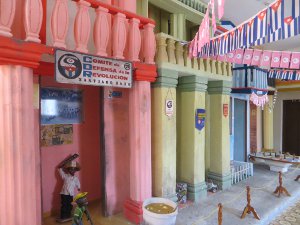
Museo 28 Septiembre de los CDR: a two-story museum explaining and justifying the need of small committees, Comites de la Defensa de la Revolución (CDR; Committees for the Defense of the Revolution), throughout the country ensuring safety and that everyone abides to the revolution.
Viñales
Viñales Plaza: founded in 1875, the city has always been more about its setting than its sights. Regardless, the town square hosts some interesting architecture such as the colonial Casa de la Cultura, one of the oldest structures in the valley, an art gallery, and a small church.
Museo Municipal: this museum is inside the former home of independence heroine, Gabriela de la Caridad Azcuy Labrador. The small museum contains local agricultural artifacts.

Viñales National Park: we hired a guide to hike around the tobacco farms and get views of the mogotes (unique rock formations). We were fortunate to visit two farmers, the first a tobacco plantation where they explained to us the entire process of making cigars and were able to even try a freshly rolled one. The second farm had a variety of crops where we tried a local drink called the canchanchara, sugar cane juice mixed with rum and honey served inside a grapefruit. We then continued walking on our own in the valley of Palmarito exploring the mogotes and the local flora and fauna. After the eight hour hike we arrived back to the town of Viñales.
Mural de la Prehistoria: this 120m-long mural was designed in 1961 by Leovigildo González Morillo and is located on a cliff at the foot of the 617m-high Sierra de Viñales. It took 18 people four years to complete. The huge snail, dinosaurs, sea monsters, and humans on the cliff symbolize the theory of evolution.
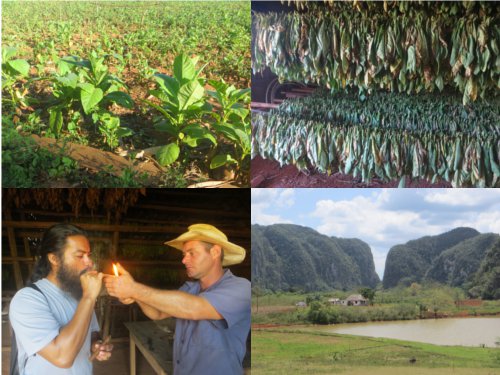
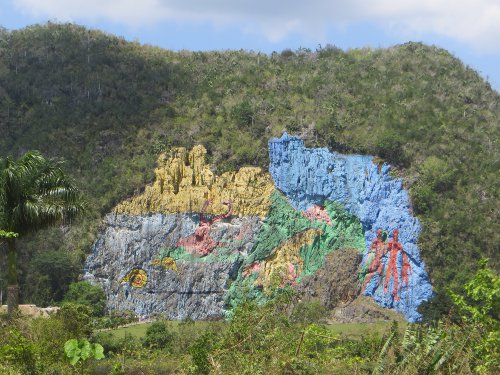
Camaguey
Monument to Mariano Baberan & Joaquin Collar: this monument is dedicated to Mariano Barberán and Joaquín Collar, Spaniards who made the first nonstop flight between Spain and Cuba in 1933, but tragically they disappeared when flying to Mexico a week later.
Plaza San Juan de Dios: the city’s most beautifully preserved plaza.
Iglesia de San Cristo del Buen Viaje: the original chapel was raised here in 1723, but this current structure is from the 19th-century. It is located adjacent to the necropolis.


Necropolis de Camaguey: the most famous person resting here is independence hero Ignacio Agramonte.
Plaza del Carmen: this cobbled-stone plaza is nicely decorated with street lamps and life-sized sculptures of locals about their daily business, such as reading newspapers, etc.
Iglesia de Nuestra Senora del Carmen: this baroque-style church dates back from 1825.
Casa Finlay: this was the birth house of a city hero, Dr. Carlos Finlay. The house is filled with artifacts the doctor used throughout his life. His most notably achievement was his medical breakthrough in discovering how mosquitoes transmit yellow fever.
Catedral de Nuestra Señora de la Candelaria: this cathedral was rebuilt in the 19th century on the site of an earlier chapel dating from 1530. The cathedral was fully restored with funds raised from Pope John Paul II’s 1998 visit.
Parque Ignacio Agramonte: this square is the heart of the city with rings of marble benches and an equestrian statue of the War of Independence hero, Ignacio Agramonte.
Maqueta de la Ciudad: in this scaled model of the country’s third largest city, including the preserved historical center, an Unesco World Heritage Site, we were able to appreciate the labyrinthine layout of the city.
Casa de Arte Jover: home to two of the country’s contemporary painters, Joel Jover and his wife Ileana Sánchez, the gallery displays original art and antiques.
Casa de la Diversidad: this museum hosted exhibitions on slavery, costumes, art, and architecture, but the most interesting asset was the colonial building it self.
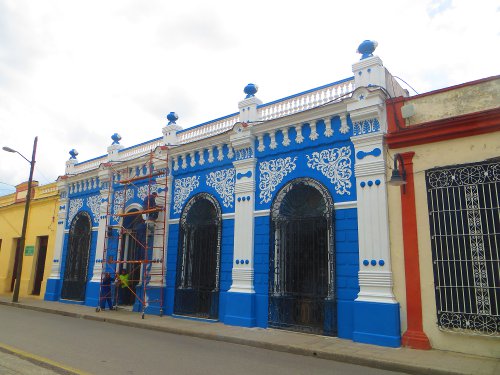
- Iglesia de Santa Ana: this church is the oldest temple in the city, as the shrine was on this spot already in 1697, but the church was build in stages from 1820-1847.
- Iglesia de San Lazaro: we went inside this church that dates back to 1700.
Iglesia de Nuestra Señora de la Merced: dating from 1748, this church is one of the city’s most impressive.
Museo Casa Natal de Ignacio Agramonte: we walked by this colonial home that was the birthplace of the independence hero Ignacio Agramonte (1841– 73), the cattle rancher who led the Camaguey area’s revolt against Spain.
Iglesia de Nuestra Señora de la Soledad: this baroque church dates back to 1779 and renovated in 2007.
Iglesia de Nuestro Corazon de Sagrado Jesus: this neo-Gothic church with its triple spire sits in the plaza, Parque Martí.
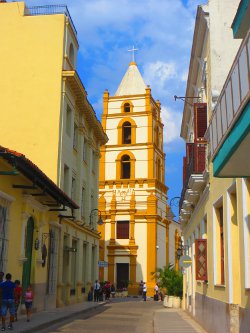

Iglesia de la Caridad: this church was originally constructed in the 18th century and received a couple of 20th-century renovations (1930 and 1945).
Mercado Agropecuario Hatibonico: we went into this outdoor market, but there was not much going on nor many products for sale. We were not sure if it was the hour we arrived or the hard times they are experiencing.
Bayamo
Plaza de la Patria: this square is where Fidel Castro gave his final public speech in July 2006 before stepping down as president. The monument in the square feautures many Cuban heros, including Fidel, the only monument he appears on in Cuba.
Teatro Bayamo: the city’s theater contains some impressive stained-glass windows.
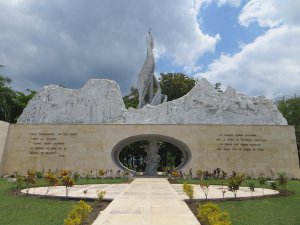
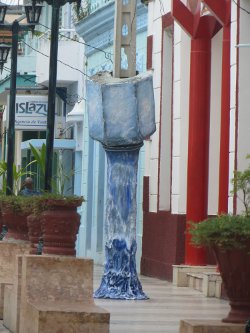
Torre de San Juan Evangelista: a church stood at this intersection until it was destroyed in the great fire of 1869. Later, the church’s tower served as the entrance to the first cemetery in Cuba. The cemetery was demolished in 1940 but the church’s tower survived.
Casa de Estrada Palma: we walked by the house of Cuba’s first post-independence president, Tomas Estrada Palma, was born in 1835.
Paseo Bayames: the city’s main shopping street became pedestrian only in the 1990’s and contains several interesting artwork.
Parque Cespedes: the city’s central meeting point was where in 1868 Cespedes proclaimed Cuba’s independence for the first time.
Iglesia Parroquial Mayor de San Salvador: there has been a church on this site since 1514, but the current structure dates from 1740 that was devastated in the 1869 fire. The church was renovated to what is now there in 1919.
Museo Ñico Lopez: this museum is in a former military barracks that was attacked by 25 revolutionaries on July 26, 1953 led by Ñico López. The attack took place in tandem with the assault on Moncada Barracks in Santiago de Cuba in order to prevent reinforcements from being sent. The museum explained the events leading to the attack, the attack itself, and the story of Lopez. After the incident he escaped to Guatemala and was the first Cuban to befriend Ernesto ‘Che’ Guevara, but was killed shortly after the Granma landed in 1956.

Parque Nacional Turquino: located inside the Sierra Maestra this national park comprises of beautiful mountainscapes, including the country’s highest peak, Pico Turquino, thick cloud forests, birdlife, and the site of the Fidel Castro’s headquarters during the revolution, Comandancia de la Plata. The camp was set up in 1958 after a year on the run in the Sierra Maestra. With a guide we hiked the 4km that took about 4 hours roundtrip to the rebel headquarters. The remote and well camouflaged site served its purpose, Batista’s soldiers never found it. The 16 basic wooden structures remain much as they were left in the 1950’s, serving as a reminder of one of the most successful guerrilla campaigns in history. We visited a small museum that helped explain the way of life in the forest, some military strategy used by Fidel, and the use of the buildings. We also visited Fidel’s house with its seven concealed escape routes in case they got discovered.
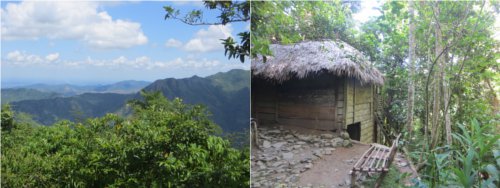
Santiago de Cuba
Museo de la Imagen: this museum guided us through a journey of Cuban radio, photography, and film with a collection of equipment and photographs.
Palacio de Pioneros: this mansion was built between 1906 and 1910, and was once the largest and most luxirious in Santiago. Since 1974 it has been a developmental center for kids.
Plaza de la Revolution: this large square has a monument of city hero, Antonio Maceo, atop his horse and surrounded by 23 raised machetes.
Cementerio Santa Ifigenia: we walked by this cementery and were able to get a glimpse of Jose Marti’s mausoleum.
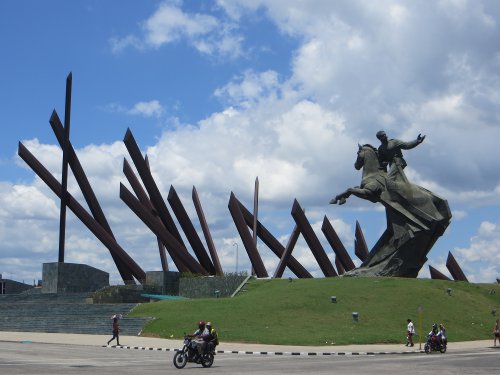
Bacardi Rum Factory: the original Bacardi factory opened in 1868 by Spanish-born founder, Facundo, in this location. The Cuban government continues to make traditional rum here under the signature Ron Caney brand as well as Ron Santiago and Ron Varadero. The Bacardi family, however, fled the island post-Revolution.
Museo Casa Natal de Antonio Maceo: this museum is hosted in the house where Antonio Maceo was born. The mulato general and hero of both Wars of Independence was born, on June 14, 1845. The exhibits include highlights of Maceo’s life with photos, letters, and other artifacts. In his 1878 Protest of Baragua, he rejected any compromise with the colonial authorities and went into exile rather than sell out to the Spanish. Landing at Playa Duaba in 1895, he marched his army as far west as Pinar del Rio before being killed in action in 1896.

Casa Museo de Frank y Josue Pais: this childhood home of brothers, Frank and Josue Pais, has been turned into a museum dedicated to them. The brothers organized the underground section of the Moncada attack in the city as well raise money for the rebels during the revolution until Frank’s murder by the police on July 30, 1957.
Tivoli Neighborhood: this old French quarter was first settled by colonists from Haiti in the late 18th and early 19th centuries. The Padre Pico steps cut into the steepest part of Calle Padre Pico and stand at the neighborhood’s gateway. The neighborhood is also where Fidel Castro lived from 1931 to 1933, while a student in the city.
Balcon de Velazquez: this was the site of an old Spanish fort which has been turned into a balcony which offers panoramic views over the Tivolí neighborhood and toward the harbor.
Parque Cespedes: this square is the heart of the city and a kaleidoscope of people walking, talking, hustling, flirting, and instrument-playing. The park is surrounded with colonial architecture.
Catedral de Nuestra Señora de la Asuncion: located on Parque Cespedes, there has been a cathedral on this site since the city’s inception in the 1520s. The present cathedral was completed in 1922.
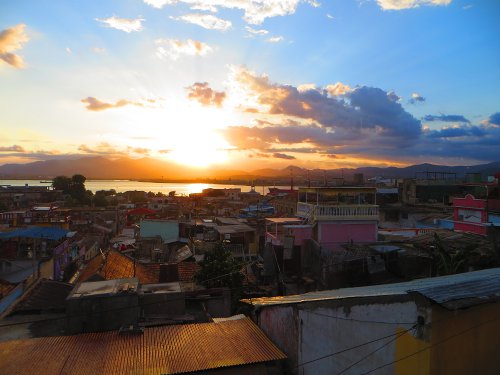

Museo de la Lucha Clandestina: this museum details the underground struggle against Batista in the 1950’s.
Maqueta de la Ciudad: this was a scaled model of the city with some interesting historical and architectural information displayed on wall panels.
Casa de Diego Velazquez: the oldest house still standing in Cuba, dating from 1522, was the official residence of the island’s first governor, Diego Velazquez. The Andalusian-style facade and the rest of the house was restored in the late 1960s.
Iglesia de San Francisco: this was an 18th-century church.
Gobierno Provincial: the provincial government seat is a building from Cuba’s 20th-century neoclassical revival.
Museo Municipal Emilio Bacardi Moreau: this museum was founded in 1899 by the city mayor, Emilio Bacardí Moreau. The museum exhibits include an art gallery, precolonial history, colonial history, wars of independence, communist revolution, and ethnography.
Memorial de Vilma Espin Guillois: the former home of Cuba’s former ‘first lady,’ Vilma Espin, the wife of Raul Castro, is now a museum dedicated to her life and accomplishments. She lived in the house from 1939 to 1959 and it was opened to the public as a museum in 2010, three years after her death. She was a daughter of a lawyer to the Bacardi clan that later became a crucial asset in the success of the Cuban Revolution and joined the rebels in the mountains after meeting Frank Pais. She also went on to found the influential Federation of Cuban Women in 1960.
Plaza de Dolores: this square was a former marketplace that is now dominated by the 18th-century church, Iglesia de Nuestra Señora de los Dolores.
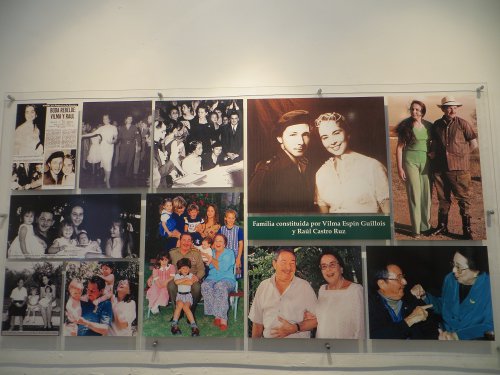

Plaza de Marte: this square marks the entrance to the historic center of the city.
Cuartel & Museum Moncada: the site of the Moncada attack on July 26, 1953, these barracks were unsuccessfully ambushed by more than 100 revolutionaries led by Fidel Castro who stormed Batista’s troops at what was then Cuba’s second-most important military garrison. After the Revolution, the barracks was converted into a school and in 1967 a museum was installed. The museum contains a scale model of the barracks, diagrams and models of the attack, its planning, and its aftermath.
Parque Historico Abel Santamaria: this park is the site of the former Saturnino Lora Civil Hospital, located across the street from the Moncada Barracks. The hospital was stormed by Abel Santamaría and 60 others on that July 26, 1953. They were later tortured and killed. On October 16, 1953, Fidel Castro was tried here for leading the Moncada attack. It was here that he made his famous History Will Absolve Me speech. The park commemorates Abel Santamaría and José Marti in a cubist fountain with their faces engraved on it.
Palacio de Justicia: this court building was taken by fighters led by Raul Castro during the Moncada attack. They were supposed to provide cover fire to Fidel’s group from the rooftop but were never needed. Many of them came back two months later to be tried and sentenced in the court.
Casa de la Trova: we were able to catch a performance of an all women group, Morena Son, in the city’s shrine to traditional music that is still going strong after five decades.
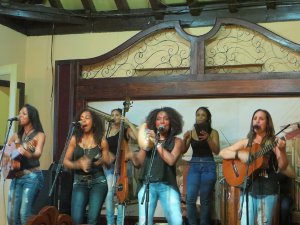
Baracoa
Museo Arqueologico ‘La Cueva del Paraiso’: this impressive archealogical museum is exhibited in a cave, La Cueva del Paraiso. The cave was once used by the indigenous group, Taino, as burial chambers. The museum displays authentic Taino pieces such as unearthed skeletons, ceramics, petroglyphs, and a replica of the Idolo de Tabaco, a sculpture found in Maisi in 1903. There also is some stairways that lead to panoramic views of the bay.
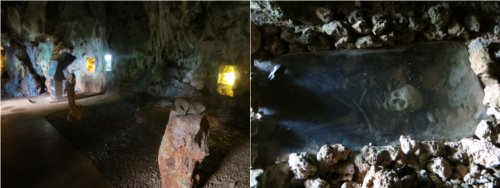
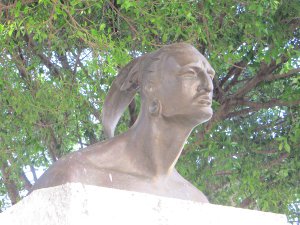
- Plaza Independencia: this triangular square hosts the city’s cathedral that dates from 1833, but there has been a building on this site since the 16th century. Facing the cathedral is the Bust of Hatuey, a rebellious native who was burned at the stake near Baracoa in 1512 after refusing to convert to Catholicism.
Fuerte de la Punta: this Spanish fort is located on the harbor entrance at the northwestern end of town. It was built in 1803 with thick walls that now is home to a restaurant.
El Castillo de Seboruco: the city’s highest fort was begun by the Spanish in 1739 and finished by the United States in 1900. It is now a luxurious hotel that is open to the public to enjoy the excellent view of El Yunque’s flat top on one side and the bay on the other.
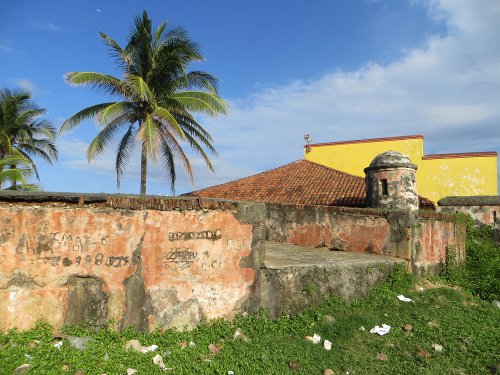

Casa del Cacao: the city is the center of Cuba’s chocolate industry and this museum/cafe chronicles the history of cocoa and its importance in eastern Cuba. We had a cold delicious chocolate drink with some Cuban rum.
Fuerte Matachin: one of three forts in the city, this one was built in 1802 at the southern entrance to town. It houses the Museo Municipal. The small museum showcases the local flora and fauna of the region, the oldest indigenous settlement on the island, the colonial times, independence from Spain, and the revolution.
Majayara Nature Park: we crossed a pedestrian bridge spanning over Rio Miel (Honey River) to get to this natural park. The bridge was actually broken at one point where we had to get a small boat to cross us the rest of the way. We then continued to Playa Blanca, a white sand beach where we sat and watched the large waves hit the adjacent rocks. We did not swim due to the danger of the big waves.
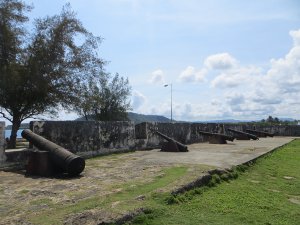
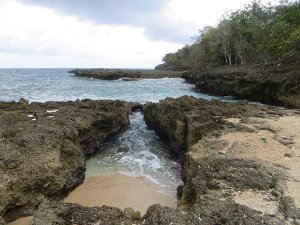
Santa Clara
Conjunto Escultorio Comandante Ernesto Che Guevara (Commander Ernesto Che Guevara Monument): this monument, mausoleum, and museum complex is dedicated the Argentinian-born Cuban hero, Ernesto ‘Che’ Guevara. A bronze statue of him was erected in 1987 to mark the 20th anniversary of Guevara’s murder in Bolivia. The mausoleum in the rear of the statue contains 38 stone-carved niches dedicated to the other guerrillas killed in the failed Bolivian revolution. In 1997, the remains of 17 of them, including Guevara, were recovered from a mass grave in Bolivia and reburied in this memorial. The adjacent museum houses the details of Che’s life and death.
Murals: on our way back from the Che monument, we ran into several murals of anti-yankee, anti-US, and anti-war, such as one that shows a US soldier breaking into a house and screaming, “Opinion Poll!!! Why so much hate against the United States?”
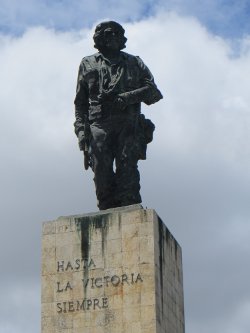
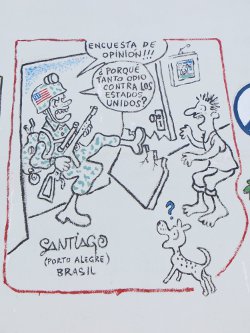
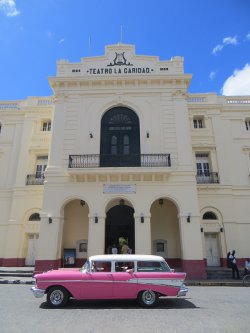
Catedral de las Santas Hermanas de Santa Clara de Asis: the city’s cathedral was constructed in 1923 after the demolition of the city’s original church in Parque Vidal.
Parque Vidal: this square was encircled by twin sidewalks during the colonial era, with a fence separating blacks and whites. Scars of more recent division are evident on the facade of Hotel Santa Clara Libre on the park’s west side: it is marked by bullet holes from the 1958 battle for the city between Guevara and Batista’s government troops. On a more upnote, the east side of the park contains Palacio Provincial where classical music is often played.
Teatro la Caridad: this theater with its neoclassical facade was built in 1885.
Monumento a la Toma del Tren Blindado: the historical turning point of the revolution took place at this site on December 29, 1958, when Ernesto ‘Che’ Guevara and a band of 18 revolutionaries derailed an armored train with 350 heavily armed troops using a borrowed bulldozer and homemade Molotov cocktails. The site has now been turned into a museum where the original train wagons host exhibitions of the event and the celebrated bulldozer is mounted at the entrance.

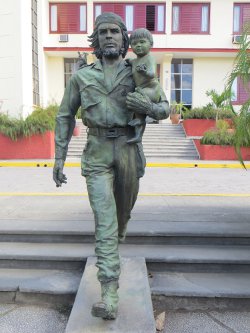
Estatua Che y Niño: this statue, Che Guevara and the Boy, features the revolutionary hero carrying a boy on his shoulder, symbolizing the next generation.
Loma del Capiro: we hiked up this hill to have a great lookout of the city and to see a metallic monument of Che Guevara. The hill was a crucial vantage point for his forces during the 1958 liberation of Santa Clara.
Iglesia de Nuestra Señora del Buen Viaje: we went inside this church that contains a mix of Gothic, Romanesque, and neoclassical architecture.
Iglesia de la Santisima Madre del Buen Pastor: this was a colonial-style church located south of the center of the city.
Iglesia de Nuestra Señora del Carmen: the city’s oldest church was built in 1748. During the War of Independence, it stood in as a jail for Cuban patriots.
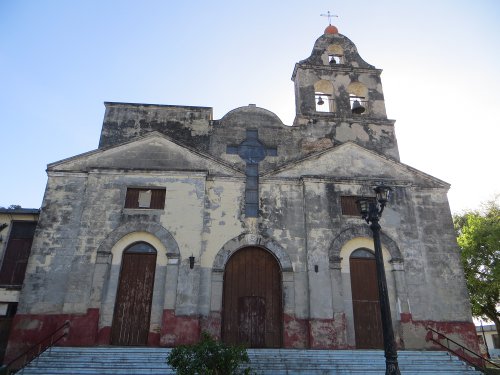
Trinidad
Museo Nacional de la Lucha Contra Bandidos: housed in the former convent of San Francisco de Asis, this museum displays photos, maps, weapons, and other artifacts relating to the struggle against the various counterrevolutionary bands that operated illicitly out of the Sierra del Escambray between 1960 and 1965. We were also able to climb the bell tower for panoramic views of the city.
Museo Historico Municipal: a mansion that belonged to the Borrell family from 1827 to 1830 and then the building passed to a German planter named Kanter, or Cantero. The building now hosts a museum displaying Cantero’s antique furniture and other artifacts he owned, exhibits on the colonial times, work in sugar plantations, Spanish Independence, Batista dictatorship, and the revolution.


Galeria de Arte: this art gallery is hosted in the 19th-century Palacio Ortiz, which displays paintings, embroidery, pottery, and jewelry.
Museo de Arquitectura Trinitaria: this museum displays upper-class domestic architecture and materials used in the 18th and 19th centuries. The museum is housed in buildings that were erected in 1738 and 1785 and joined in 1819.
Iglesia Parroquial de la Santisima Trinidad: this church is located on the northeastern side of Plaza Mayor was rebuilt in 1892 on the site of an earlier church destroyed in a storm.
- Plaza Mayor: this remarkable square is located in the heart of the old town and surrounded with impressive colonial buildings.
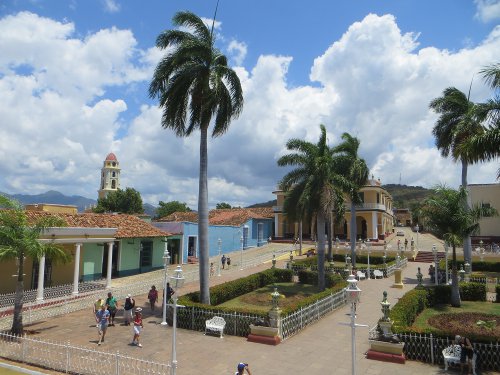
Casa Templo de Santeria Yemaya: Santeria is Cuba’s main religion of African origin and this temple worships Yemaya, Goddess of the Sea. We were fortunate to find a santero, Santeria priest, who explained to their beliefs and traditions.
Maqueta de Trinidad: this scaled model of the city’s old town opened in 2014 and is very detailed.
Museo de Arqueologia Guamuhaya: this archaeological museum contains artifacts of the indigenous from the area and colonial periods.
Iglesia de Santa Ana: only the ruins remain of this 1812 church.
Plaza Santa Ana: this square is located northeast of the city, where we spent some time watching kids play the up and coming sport of soccer on the island.
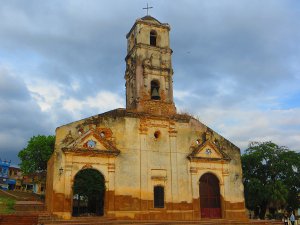
Casa de la Musica: one of Cuba’s classic venues, this site hosts outdoor concerts where locals and tourists congregate on a staircase. We listened to live trova and salsa music while enjoying some mojitos.
Listening to Trova Music in Casa de la Musica
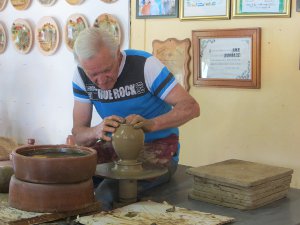
Taller Alfarero: this city is known for its pottery and we were not only able to visit this factory, but also interact and see the owner at work on a traditional potter’s wheel. He explained to us the business has been part of his family for five generations. He kindly gave us a piece of his art, a ceramic candle holder, after we helped him translate to other tourists.
Playa Ancon: we originally tried biking to this pristine white beach, but Gisela’s bike got a flat, so the next day we took a bus out and enjoyed some swimming on what is considerd Cuba’s finest arc of sand on south coast.
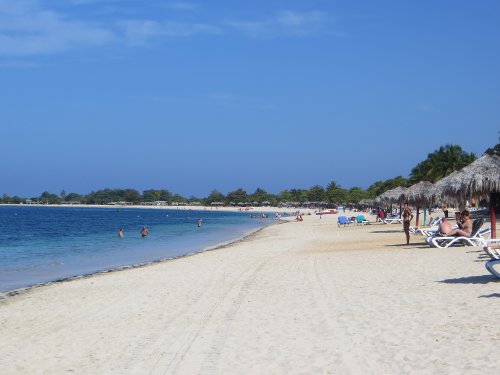
Cienfuegos
Malecon: this seaside walkway offered fine views of the beautiful city bay.
Palacio Azul: a 1920’s grandiose blue mansion with its red-orange cupola is now a hotel, Hostal Palacio Azul.
Club Cienfuegos: once an exclusive yacht club, it sill offers nautical excursions, but now functions more as a restaurant with other stores.
Palacio de Valle: built in 1917 by Acisclo del Valle Blanco, a Spaniard, this structure resembles a Moroccan kasbah. Batista planned to convert the building into a casino, but today it is an upscale restaurant.
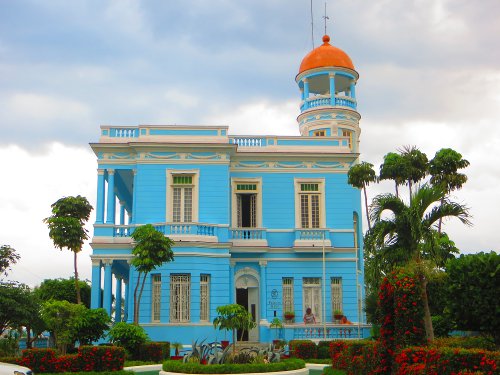
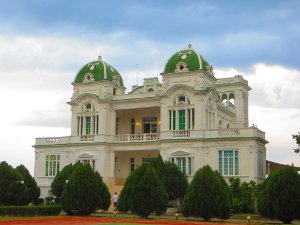

Parque de Esculturas: this sculpture park features some modern works of art.
Centro Recreativo la Punta: located on the extreme southern tip of the city, we came to the park to be able to enjoy the sunset, but unfortutanely it was too cloudy for that.
Statue of Benny More: this statue is of the most famous city musician featured with his trademark cane.

Museo Provincial: this museum displayed some information on the areas indigenous, an art gallery, and the modern history of the region from founding to present.
Palacio de Gobierno: located on the south side of Parque Jose Marti, this large silvery-gray building is where the provincial government meets.
Casa del Fundador: on the southeastern corner of Parque Jose Marti stands the city’s oldest building, once the residence of city founder Louis D’Clouet.
Catedral de la Purisima Concepcion Church: we visited the interior of the city’s cathedral that dates from 1869 with its wonderful stained-glass windows.
Colegio San Lorenzo: this building with its colonnaded facade was constructed during the 1920’s.
Teatro Tomas Terry: this theater on the northern side of Parque Jose Marti was built between 1887 and 1889 to honor Venezuelan industrialist Tomas Terry.
Arco de Triunfo: the Arch of Triumph on the western edge of Parque Jose Marti is dedicated to Cuban independence.
Casa de la Cultura Benjamin Duarte: the former Palacio de Ferrer built in 1918 is a neoclassical building that now hosts a cultural house.


Castillo de Nuestra Señora de los Angeles de Jagua: built one century prior to the city of Cienfuegos, this castle located west of the mouth of the bay was designed by Jose Tantete in 1738 and completed in 1745. At the time of completion, the fort was Cuba’s third most important and was to keep pirates and the British out. It was renovated in 2010 that included a museum with exhibits of the history of the area, including plans of a nearby nuclear power plant, a joint venture between Cuba and the Soviet Union that halted to a stop along with the USSR. We were able to get a glimpse of the power plant from the fort along with beautiful views of the bay. The journey to the castle, a 40-minute ferry, was also a pleasant experience.
Playa Giron
Caleta Buena: eight kilometers southeast of Playa Giron, this lovely cove was perfect for snorkeling. The coral and fish are unique to the area due to the misture of saltwater and freshwater. The admission to the site included an all-you-can-eat lunch buffet and open bar, great excuse to spend the whole day there drinking, swimming, eating, and relaxing.
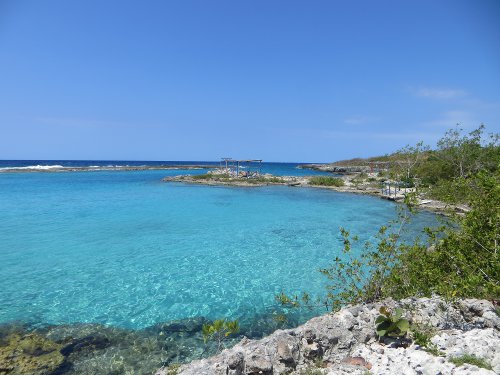
Scuba Diving: we were fortunate to do one immersion in Punta Perdiz, Bay of Pigs. The island is famously known for its diving, Fidel was a big fan, and this bay has a huge drop running 30m to 40m offshore, which meant the sites are easily accessed without a boat. The natural feature also has created a 300m-high coral wall with amazing caves and marine life with great visibility.


Museo de Playa Giron: this museum tells the story of the impoverished area around the bay before the revolution and features the renowned Bay of Pigs attack by the US in 1961. The museum is filled with artifacts and photos of the event and the victorious result for Cuba, which they call the first US defeat in Latin America. There are aircraft and other vessels used by the Cubans in the front of the museum.
